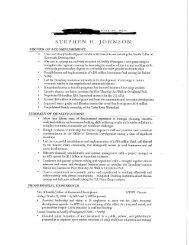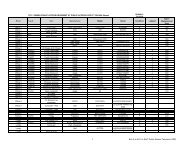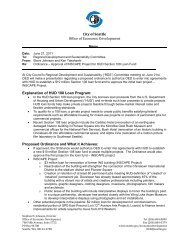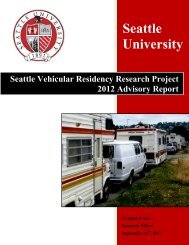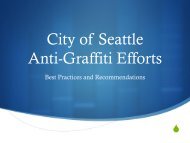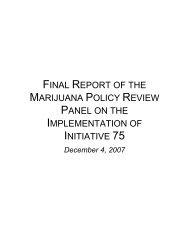2013 Water System Plan, Volume II - Seattle City Clerk's Office - City ...
2013 Water System Plan, Volume II - Seattle City Clerk's Office - City ...
2013 Water System Plan, Volume II - Seattle City Clerk's Office - City ...
Create successful ePaper yourself
Turn your PDF publications into a flip-book with our unique Google optimized e-Paper software.
is anticipated that all of SPU’s open reservoirs will be covered or removed from service in the<br />
near future. Once completed, taste and odor testing for those locations will discontinue.<br />
Reservoir Protection<br />
Each of SPU’s in-town open reservoirs, and several closed reservoirs, currently have chlorination<br />
at the outlet or within a mixing system, prior to entry to the distribution system. The chlorine<br />
residual is monitored continuously to ensure adequate treatment occurs at all times. In addition,<br />
weekly check samples are collected and analyzed by laboratory staff for chlorine, total coliform,<br />
fecal coliform, E. Coli, pseudomonas, phytoplankton, pH, and HPC from the reservoir outlet and<br />
mid-reservoir. Treatment staff check each open reservoir treatment system daily. As required by<br />
WAC 246-290-470, SPU maintains and operates the open reservoirs according to a DOH<br />
approved Open Reservoir Protection <strong>Plan</strong>. In addition, DOH has approved SPU’s Reservoir<br />
Covering <strong>Plan</strong>, which will replace, cover, or abandon all open reservoirs by 2018.<br />
Treatment Processes<br />
Existing source water treatment consists of ozonation, UV light, chlorination, fluoridation, and<br />
corrosion control on the Cedar supply. Treatment for the Tolt supply consists of ozonation,<br />
coagulation, flocculation, filtration, corrosion control, chlorination and fluoridation. Each of<br />
these processes is monitored continuously to ensure adequate treatment is maintained at all<br />
times. Portions of this monitoring are required by the regulations discussed above. Significantly<br />
more monitoring is required to meet the requirements of the Service Agreements for each DBO<br />
contractor operating the treatment plants. This monitoring is summarized in Table 3.<br />
2.4 Sampling Procedures<br />
Proper sample collection is important for accurate results. All laboratory assistants and other<br />
staff collecting samples in the field are trained in appropriate sample collection techniques based<br />
on parameter. Written sample collection procedures for bacteriological analyses such as total<br />
coliform are included in SPU’s Coliform Monitoring <strong>Plan</strong>. Sample collection methods for all<br />
regulatory compliance samples follow standard procedures or methods listed in Standard<br />
Methods. In addition, training for laboratory staff conducting the analyses occurs on a regular<br />
basis.<br />
2.5 Laboratory Information Management <strong>System</strong> (LIMS)<br />
Beginning in 2006, SPU’s <strong>Water</strong> Quality Laboratory implemented a new Laboratory Information<br />
Management <strong>System</strong> (LIMS). All water quality samples analyzed at the lab, or samples<br />
analyzed by outside laboratories for SPU’s drinking water are entered into LIMS. This system<br />
provides the means to track sample status, record and validate results, and produce reports. Data<br />
from LIMS can then be extracted to other computer programs for long-term storage, analysis, or<br />
report formatting.<br />
Comprehensive <strong>Water</strong> Quality Monitoring <strong>Plan</strong> Page 8 of 12



